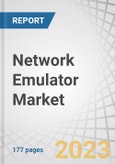However, despite these growth drivers, the market faces notable restraints. High implementation and operational costs, especially for advanced hardware-based emulators, can deter adoption among small and medium-sized enterprises. Additionally, the complexity of configuring and interpreting network simulations, coupled with a lack of skilled personnel, poses challenges for broader usage. The presence of low-cost or open-source alternatives also puts pressure on premium solution providers. Moreover, limited awareness and adoption in developing regions further constrain market expansion. Overall, while the network emulator market holds significant promise, vendors must address these barriers through innovation, affordability, and education to unlock its full potential.
Based on offering, the hardware segment is expected to hold the largest market share during the forecast period.
Hardware in a network emulator helps in delivering high-performance, real-time, and accurate network simulations across various industries. These hardware components, such as custom-built appliances, FPGAs, and advanced network interface cards, enable low-latency and high-throughput emulation, which is essential for simulating real-world network conditions such as latency, jitter, packet loss, and congestion. Hardware-based emulators are widely used in applications such as 5G and mobile network testing, data center validation, defense communication systems, automotive and industrial IoT networks, and cybersecurity testing. They support integration with physical test environments and offer precise Layer 1-3 protocol emulation, making them ideal for testing mission-critical and time-sensitive systems.Based on vertical, the BFSI segment is projected to register the highest CAGR during the forecast period.
In the BFSI sector, network emulators play a crucial role in ensuring the performance, reliability, and security of critical digital infrastructure. These emulators allow financial institutions to simulate real-world network conditions such as latency, packet loss, and jitter, enabling them to test how trading systems, mobile banking apps, and transaction platforms behave under various scenarios.This is particularly important for high-frequency trading systems that demand ultra-low latency and for mobile applications accessed over fluctuating network environments. Network emulators are also used to validate disaster recovery mechanisms, test cybersecurity defenses against simulated attacks, and ensure compliance with regulatory requirements such as PCI DSS. Additionally, they support cross-border transaction testing, helping institutions ensure smooth and secure operations across global networks. By using network emulators, BFSI organizations can proactively identify potential performance bottlenecks and security gaps, ultimately delivering a seamless and trustworthy experience to their customers.
Asia Pacific is expected to witness the highest CAGR during the forecast period.
The network emulator market in Asia Pacific is witnessing the fastest growth globally, driven by rapid digital transformation, expanding 5G deployments, and rising demand for high-performance, secure network infrastructures. Countries such as China, India, Japan, and South Korea are heavily investing in next-generation technologies, including smart cities, autonomous systems, and advanced telecom infrastructure, all of which require robust network testing and validation.Network emulators are increasingly used across sectors such as telecom, BFSI, IT, and manufacturing to simulate real-world conditions, ensure application performance, and meet regulatory requirements. The surge in fintech and e-commerce activities in the region also amplifies the need for low-latency, secure network operations, further boosting emulator adoption. With growing investments, increased R&D, and rising awareness about network reliability and security, Asia Pacific is emerging as a strategic hotspot for network emulator vendors aiming to capture high-growth opportunities.
Breakdown of Primaries
Chief Executive Officers (CEOs), directors of innovation and technology, system integrators, and executives from several significant network emulator market companies were interviewed.- By Company Type: Tier I: 62%, Tier II: 23%, and Tier III: 15%
- By Designation: C-Level Executives: 38%, Director Level: 30%, and Others: 32%
- By Region: North America: 40%, Europe: 15%, Asia Pacific: 35%, Rest of World: 10%
Research Coverage:
The market report covered the network emulator market across segments. The market size and growth potential for many segments were estimated based on offering, application type, test type, vertical, and region. It contains a thorough competition analysis of the major market participants, information about their businesses, essential observations about their product offerings, current trends, and critical market strategies.Reasons to Buy this Report:
With information on the most accurate revenue estimates for the whole network emulator industry and its subsegments, the research will benefit market leaders and recent newcomers. Stakeholders will benefit from this report's increased understanding of the competitive environment, which will help them better position their companies and develop go-to-market strategies. The research offers information on the main market drivers, constraints, opportunities, and challenges, as well as aids players in understanding the pulse of the industry.The report provides insights on the following pointers:
- Analysis of key drivers (Increasing attacks and security breaches on networks, rise in virtualization and cloud adoption, and the need for reduced downtime in networking), restraints (Longer timelines and extended R&D requirements for new networking technologies, and price sensitivity of network testing and emulators), opportunities (Increasing demand for software-defined networking and virtualization, and multi-protocol support and advanced functions provided by same hardware emulator, investments in R&D and positive outcomes from testing phase of 5G networks), and challenges (Lack of skilled workforce to comprehend and report issues in networking and fast-changing network requirements).
- Product Development/Innovation: Comprehensive analysis of emerging technologies, R&D initiatives, and new service and product introductions in the network emulator market.
- Market Development: In-depth details regarding profitable markets: the paper examines the global network emulator market.
- Market Diversification: Comprehensive details regarding recent advancements, investments, unexplored regions, new goods and services, and the network emulator market.
- Competitive Assessment: Thorough analysis of the market shares, expansion plans, and service portfolios of the top competitors in the network emulator industry, such as Spirent Communications (US), Keysight Technologies (US), VIAVI Solutions (US), Calnex Solutions (UK), Rohde & Schwarz (Germany), Polaris Networks (US), PacketStorm (US), SolarWinds (US), InterWorking Labs (US), Apposite Technologies (US), ADVANTEST (Japan), GL Communications (US), Valid8 (US), Aldec (US), Marben Products (France), Aukua (US), Simnovus (US), EVE-NG Pro (UK), GigaNet Systems (US), Qosmotec Software Solutions GmbH (Germany), TETCOS (India), Modulo Communications Systems (Israel), Nihon Communications Systems (India), and NextGig Systems (US).
Table of Contents
Companies Mentioned
- Spirent Communications
- Keysight Technologies
- Apposite Technologies
- Calnex Solutions
- Viavi Solutions
- Rohde & Schwarz
- Polaris Networks
- Packetstorm
- Solarwinds
- Interworking Labs
- W2Bi
- Gl Communications
- Valid8
- Aldec
- Marben Products
- Aukua
- Simnovus
- Eve-Ng Pro
- Giganet Systems
- Qosmotec Software Solutions GmbH
- Tetcos
- Modulo Communications Systems
- Nihon Communications Systems
- Netgig Systems
Table Information
| Report Attribute | Details |
|---|---|
| No. of Pages | 203 |
| Published | June 2025 |
| Forecast Period | 2025 - 2030 |
| Estimated Market Value ( USD | $ 252.4 Million |
| Forecasted Market Value ( USD | $ 361.4 Million |
| Compound Annual Growth Rate | 7.4% |
| Regions Covered | Global |
| No. of Companies Mentioned | 24 |









